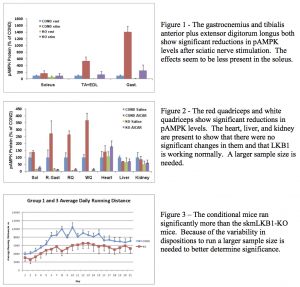Darren Goring and Dr. David Thomson, Department of Physiology and Developmental Biology
The original purpose of this study was to elucidate the effects of muscle stimulation on gene expression for mitochondrial proteins in mLKB1-KO mice (mice in which the LKB1 gene has been knocked out of the muscles and heart). LKB1 is an important protein involved in the signaling of mitochondrial protein production. The original protocol was to run the mice on a treadmill fast enough and long enough to cause transcription of mitochondrial proteins. I hypothesized that the mLKB1-KO mice would still have some mitochondrial gene expression but to a lesser degree than the conditional mice.

Soon into the study, we realized that the mice would not be able to run enough to elicit the necessary responses. With this in mind, we obtained a different strain of mice with LKB1 knocked out only in the skeletal muscle (skmLKB1-KO mice). Our hope is that these mice will be able to sustain the necessary requirements for running to elicit the transcription of mitochondrial genes. Before we could run the same experiment with these mice, we needed to verify their resemblance to the mLKB1-KO mice. The verification experiments spanned the most part of my mentoring experience, and we are just starting the treadmill running experiment with the new strain of mice.
The first verification experiment performed involved the stimulation of the sciatic nerve in the mice. The left leg was stimulated on skmLKB1-KO mice and conditional mice while the right leg was not. The soleus, tibialis anterior and extensor digitorum longus, and gastrocnemius were harvested from each leg. A western blot, a test used to detect the presence of proteins, was run to determine the levels of LKB1 and pAMPK. AMPK is a downstream protein normally phosphorylated by LKB1. The results, shown in Figure 1, show that pAMPK levels were much lower in the skmLKB1-KO mice than the conditional mice.
The second verification experiment utilized a drug called AICAR that mimics the effects of exercise in cell signaling. Conditional mice and skmLKB1-KO mice were injected and then the soleus, gastrocnemius, white quadriceps, and red quadriceps were harvested. As a control, some of the mice were injected with a saline solution. The results, shown in Figure 2, show that pAMPK levels are dramatically lower than in the conditional mice.
The final verification experiment examined voluntary running of the skmLKB1-KO mice versus the conditional mice. The running mice were housed in cages equipped with a running wheel. The control mice were placed in normal cages. The experiment lasted three weeks. The results, shown in Figure 3, show that on average, the skmLKB1-KO mice run less than conditional mice. Further analyses will look at differences in adaptations in the mice.
The current experiment we are performing relates to the original plan of running the mice on a treadmill and looking at mitochondrial protein gene expression. On the first day of the experiment, all the mice were run starting at 12 m/min for two minutes, then 15 min/min for three minutes, and then the speed was increased by 1 m/min thereafter. The mice were allowed to run till fatigued. After this initial test, equal numbers of skmLKB1-KO and conditional mice were chosen to participate in the treadmill training protocol in which the mice are run four days a week for one hour while trying to increase the speed each time. At the end of four weeks of training, all the mice, including the ones that did not participate in the treadmill training, will undergo the same test as the initial one. We will then compare the abilities of the trained mice versus the sedentary mice. We will also look at mitochondrial protein gene expression and other adaptations in the mice.
While the study did not go as planned, the experience I gained is the same, regardless. Unfortunately, due to my graduating, I will not be able to see the study to its end. Despite this fact, the study will eventually be completed and presented for publication in a scientific journal. I look forward to learning the results of the final experiment.
